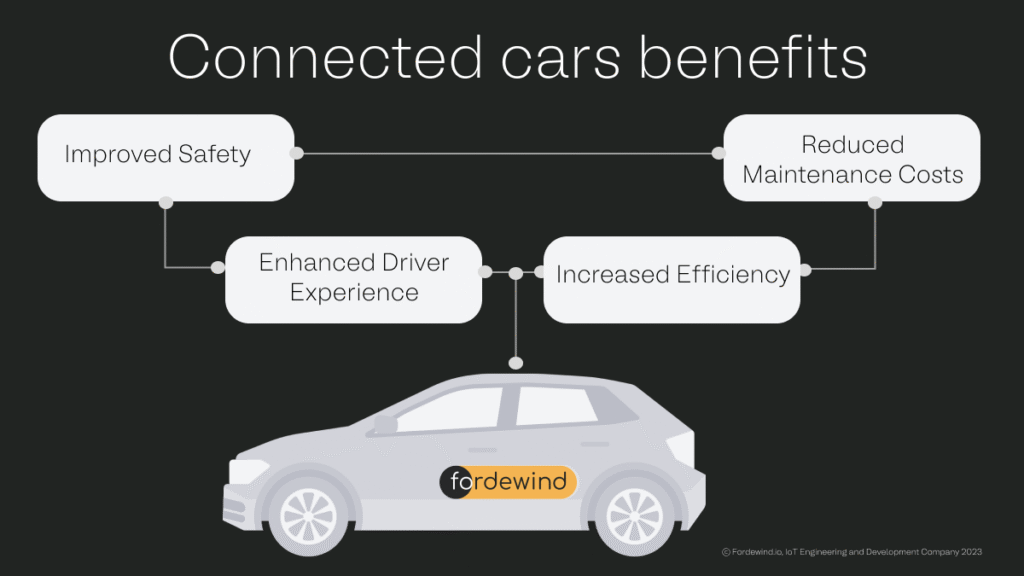✆ + 1-646-235-9076 ⏱ Mon - Fri: 24h/day
The Future of Connected Cars


The automotive industry is currently undergoing a significant transformation, thanks to IoT technologies. Connected cars are becoming increasingly common, and they are changing the way we think about driving, safety, and transportation as a whole. With the rapid growth of IoT technology, it is not surprising that the automotive industry is now exploring new ways to integrate it into their vehicles.
First of all, what are Connected Cars?
Connected cars are vehicles that are equipped with internet connectivity and other technologies that allow them to communicate with other devices, networks, and services. These technologies include sensors, GPS, cameras, and other devices that can collect data and send it to a cloud-based platform.
Connected cars offer a wide range of benefits, including improved safety, better fuel efficiency, and enhanced driver convenience. They also provide the ability to access real-time data about the vehicle’s performance, location, and other important information.
Secondly, it is vital to mention the connection between IoT and Connected Cars.
The Internet of Things has had a significant impact on the automotive industry. IoT technology is now being used to develop more sophisticated and intelligent vehicles that can communicate with other devices and systems. For example, sensors and cameras can be used to detect traffic conditions, road hazards, and other potential dangers.
IoT technology also allows for more efficient vehicle maintenance. By collecting data about the vehicle’s performance, manufacturers can identify potential issues before they become major problems. This can help prevent breakdowns and reduce the cost of repairs.
One of the most exciting possibilities for IoT technology in the automotive industry is the development of autonomous vehicles. These vehicles use sensors and other technologies to navigate roads and highways without human intervention. This could revolutionize the way we think about transportation and provide a safer, more efficient means of travel.
Moreover, connected cars offer a wide range of benefits for both drivers and manufacturers. Here are just a few of the advantages of IoT-enabled vehicles:


- Improved Safety: IoT technology can help improve safety by providing real-time data about the vehicle’s performance, road conditions, and potential hazards. This can help drivers make better decisions and avoid accidents.
- Enhanced Driver Experience: Connected cars can provide a more enjoyable driving experience by offering features such as personalized music playlists, voice-activated controls, and real-time traffic updates.
- Increased Efficiency: IoT-enabled vehicles can be designed to be more fuel-efficient and environmentally friendly. By collecting data about the vehicle’s performance, manufacturers can identify ways to reduce emissions and improve overall efficiency.
- Reduced Maintenance Costs: By collecting data about the vehicle’s performance, manufacturers can identify potential issues before they become major problems. This can help prevent breakdowns and reduce the cost of repairs.
As IoT technology continues to evolve, the future of connected cars looks bright. We can expect to see even more sophisticated and intelligent vehicles that are capable of communicating with other devices and systems. Some of the key developments to look out for include:
-Autonomous Vehicles: The development of autonomous vehicles will continue to be a major focus for the automotive industry. These vehicles have the potential to revolutionize the way we think about transportation, providing a safer, more efficient means of travel.
-Enhanced Connectivity: Connected cars will become even more connected in the future, with the ability to communicate with other devices and services in real-time. This will enable new features and services that are not possible with traditional vehicles.
-Advanced Safety Features: IoT technology will be used to develop even more advanced safety features, such as collision detection and emergency braking systems.
In conclusion, the Internet of Things is transforming the automotive industry, and connected cars are just the beginning. As IoT technology continues to evolve, we can expect to see even more sophisticated and intelligent vehicles that are capable of communicating with other devices and systems.
Fordewind.io is an IoT engineering and development company based in Kyiv, Ukraine. Our main areas of interest and expertise are the automotive industry and Smart Home/City projects. Contact us right now without a doubt and learn more about how we can help you build the future.